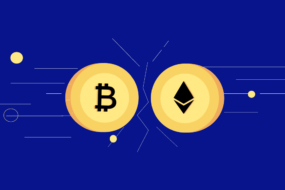
There was a time when the word assets used to have a limited definition and included traditional options such as a bank fixed deposit, stocks, gold, real estate, etc. However, with time and technological advancements, new investment avenues started to evolve, broadening and transforming the concept of assets to – digital assets. A few examples of digital assets are Cryptocurrencies and NFTs.
This innovative and technology-led asset class provides investors with the much-needed flexibility, transparency, and ease of investing. However, the question is – what are digital assets and why have they had so much traction in recent years?
What Are Digital Assets?
Digital assets are electronically stored data or information that have value and can be owned, exchanged, or transferred. They include cryptocurrencies, tokens, digital collectibles, and other forms of intangible assets. They are managed using blockchain technology or centralized databases.
How Do Digital Assets Work?
Digital assets are based on blockchain technology. Blockchain acts as a distributed ledger with a focus on decentralization for storing and keeping records of transactions related to virtual assets, i.e., Bitcoin.
Because digital assets act as valuable assets that can be bought and sold, you require a digital wallet to facilitate that.
Digital assets are broadly secured, but to prevent fraudulent activities such as theft, a layer of security is added to the wallet using public and private keys. These keys are a combination of numbers and alphabets that gives you access to your digital assets; you need both of these keys. If you lose them, the chances of you being able to access your assets disappear forever. While anyone can see which digital assets a wallet holds, without sharing personal data, no one can know which wallet belongs to whom.
What Are the Different Types of Digital Assets?
We can divide digital asset types into two sections. The first one is digital assets in the general sense, which we covered under what are digital assets. The second is the newer types of digital assets based on blockchain.
Some common types of digital assets are as below:
11 Different Forms of Digital assets
- 1.Documents
- 2.Videos
- 3.Photographs
- 4.E-books
- 5.Audio files
- 6.Illustrations
- 7.Brand logos
- 8.Animations
- 9.Content
- 10.Social media
- 11.Metadata
Digital assets based on blockchain
- Cryptocurrencies
- Non-fungible Tokens (NFTs)
- Different types of Tokens
Examples of Digital Assets
We can divide digital assets into three main categories, as mentioned below. Each type of digital asset has a different utility and purpose.
1. Cryptocurrencies and NFTs
Well, you would definitely have heard about these two digital assets. Cryptocurrencies and NFTs have become buzzwords in the last couple of years. Cryptocurrencies are virtual currencies based on blockchain; Bitcoin, Ethereum, USD coin, etc., are some of the popular examples. You can further divide them into different types of cryptocurrencies based on the purpose of their creation, such as payment tokens, utility tokens, exchange tokens, etc.
On the other hand, NFT is a digital form of any art, photograph, or unique physical/digital item. They store the value of physical/digital items in a virtual format.
2. Asset-backed tokens
Asset-backed tokens are tied to a physical asset. In other words, they are backed by physical assets or commodities. Such physical assets are likely to be gold, USD commodities like soybeans, and more. For example, a stablecoin is one such asset-backed token; its value is tied to the US Dollar.
3. Tokenized commercial real estate
This digital asset is quite interesting as it literally creates a digital ownership version of commercial real estate property. It allows users to buy and sell properties in a virtual space and benefit from price raises, just like in the real world. With tokenized commercial real estate, you can buy and sell any property in the world, even the Pyramids of Giza and the Eiffel Tower.
What Are the Pros and Cons of Digital Assets?
Below are the primary advantages and disadvantages of digital assets.
Pros of digital assets
1. Anyone can invest and participate
One of the biggest advantages of digital assets is that anyone can participate and invest in them. If you want to buy an NFT, crypto, or even a virtual piece of the Taj Mahal, you can do so without any hurdles. Digital assets allow the general public to invest and even create new assets with ease.
2. It is secured
Because digital assets are based on blockchain technology, they protect users’ data and offer them great data security. All the transactions of digital assets are recorded on a disturbed ledger. To add new transactions to this ledger, digital assets use different consensus frameworks, such as proof of work and proof of stake. In short, the technology backing virtual assets ensures they are secured.
3. Serves as an investment option
Digital assets are good investment options and can help you diversify your portfolio. However, before jumping into this asset class, you should learn to invest in it. Prices of digital assets like Bitcoin have skyrocketed since its inception, providing greater returns to investors. However, you should also keep in mind the risk factors involved.
Cons of digital assets
1. A thorough understanding is a must
Whether you want to create a digital asset or invest in it, you need a thorough knowledge and understanding of this space. If creating digital assets is your area of interest, you must have technological skills. For investing in digital assets, you need to learn how to read between the lines of market volatility and perform fundamental and technical analysis so that your investments can yield some returns. You should also educate yourself about all the risks involved in investing in this asset class.
2. Mistakes cannot be reversed due to blockchain
Once you add a new data block to the system, you cannot reverse anything, even mistakes, because blockchain transactions are irreversible.
3. Risk of scams and frauds
No doubt that blockchain makes digital assets safe and secure. However, since blockchain transactions are anonymous, it is a fertile opportunity for fraudsters and scammers to find ways to steal and launder money. Though it’s really difficult, it is possible.
What Are the Two Factors Influencing the Value of Digital Assets?
Two major factors influence the overall value of digital assets: i) The time and ability to produce digital assets and ii) The ability to reproduce digital assets.
1. Time and ability to produce
The efforts and time required to create a digital asset make all the difference in its value. You can compare it with a normal life experience, such as buying a hand-crafted art piece vis-a-vis one made by a machine. A hand-crafted piece takes a great deal of time and effort, which is directly in proportion to the value at which the creator sells it. The same logic applies to digital assets. The more niche and meticulous the creation of an asset, the more its value.
For instance, Bitcoin is valued so highly only because of two reasons. Firstly, it has a limited supply, and secondly, it is really difficult to create new Bitcoins; and with time, it only gets tougher.
2. Ability to reproduce
You would know the value of the Monalisa painting by Leonardo da Vinci in the Louvre museum–it is one of its kind and a single piece. It contributes to its value directly. In the same way, the more unique a digital asset is, the more its value is. You can take an example of NFT of Jeff Koon’s 1986 painting Rabbit. It was sold for a whopping $91 million. Hence, the less the possibility to reproduce and replicate a digital asset, the higher its value.
Why Is DAM (Digital Assets Management) Important?
Well, now that we have touched upon what digital assets are and their types and importance, let’s see how DAM is crucial to managing this dynamic asset class.
But first, the question is, what is digital asset management? It is a one-stop destination for individuals and businesses in this space to create, store, manage, and distribute digital assets. It helps manage the entire lifecycle of digital assets, making the work easier and more convenient for users. Think of it as a very organized and labeled drawer in your closet, with the only difference being that a DAM system is digital, and you use it for virtual assets.
Digital asset management saves time for users by sorting files in a particular manner using metadata so that searching them becomes easy. Metadata is the data tag you use to identify other data; in simple words, it’s a label given to a data set. It makes the process of using and distributing digital assets very smooth.
While the usage of DAM’s feasibility may not be higher for individuals, for businesses and start-ups dealing in digital assets, it holds significant value.
Want to Invest in Digital Assets? What Should You Consider?
If reading about digital assets has intrigued you to explore this space for investing, here are two important points you must consider before venturing into your options.
1. Research on risk and return
Of course, for anyone, the primary goal for investing money is to gain a return. However, that can only happen if the selected digital asset has that potential. You must research well and perform a thorough analysis before putting your money into any digital assets. Also, look after the risks involved, such as regulatory risks, volatility, etc., before investing your money. Keep in mind that there is no alternative to doing your homework on the research part.
2. Diversify your portfolio
Never put all your money in one basket. This is very true for any investment. If you are investing in digital assets to diversify your existing portfolio, go ahead. However, diversify your digital asset portfolio as well. It means that you do not put all your money into a single digital asset. You can invest in different types of cryptos instead of just Bitcoin. This will reduce your overall portfolio risk.
This was the basics. Now let’s talk about how you can buy these assets.
Buying digital assets is as simple as buying stocks. You just have to open an account with a crypto platform that facilitates the trading of your preferred digital asset. It will ask you for your basic personal and bank details to transfer the money to your wallet and purchase a digital asset. That’s it.
Visit Mudrex’s Coin Sets if you are confused about which digital assets you should buy. It has all your needs sorted with different options available, from NFTs to Cryptos, at a touch away.
What Does the Future Hold for Digital Assets?
Digital assets have become quite popular recently and are likely to expand more, with countries and governments recognizing their value. For example, the Indian government has announced the launch of the Digital Rupee. In addition, according to a report by Statista, total revenue in the digital assets space is likely to be US$37,240.00 million for the current year. And they forecast it to reach US$82,710.00 million by the year 2027 at a 17.30% CAGR growth. For the same period, they also expect the number of users to increase to 412.18 million. Well, the numbers speak for themselves and tell the story of growth we are yet to witness.
FAQs
1. What are digital assets?
Anything that you store online and holds a certain value is a digital asset, i.e., documents, photos, videos, etc. From an investment perspective, assets based on blockchain are classified as digital assets. Cryptocurrencies and NFTs are two popular examples of digital assets.
2. Do Bitcoins come under digital assets?
Yes. Because Bitcoins are cryptocurrencies, and cryptocurrencies are a type of digital asset. Thus, Bitcoin is one of the digital assets. Even NFTs are digital assets. They act as valuable assets that you can buy and sell.
3. Are digital assets stored on the blockchain?
Yes, digital assets are stored on the blockchain. Blockchain is a distributed ledger that safely and securely stores all digital assets’ transaction details. Examples of digital assets stored on blockchain include cryptocurrencies, NFTs, and more.
4. What is the difference between crypto assets and digital assets?
Crypto assets are a part of digital assets. All crypto assets are digital assets; however, we can not say that all digital assets are cryptos. While crypto assets include cryptos and asset-backed tokens, digital assets can consist of NFTs and even documents and videos that are not investment means.
5. Should you invest in digital assets?
This answer depends on how much you know about the assets you are investing in. If you do your own research and are well aware of the potential and risks of digital assets, it can definitely be a good option to diversify your investment portfolio.




